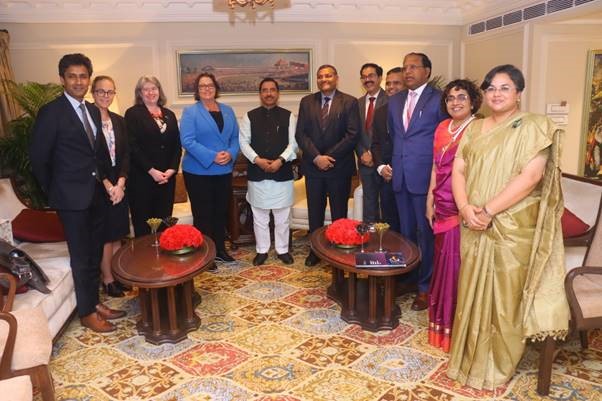Description

Disclaimer: Copyright infringement not intended.
Context: India and Australia have reached a major milestone in working towards investment in critical minerals projects to develop supply chains between the two countries.
Details:
- The Union Minister for Coal, Mines and Parliamentary Affairs and Minister for Resources and Northern Australia held bilateral talks and announced the Partnership has identified five target projects (two lithium and three cobalt) on which to undertake detailed due diligence
- Ministers from the two countries have also agreed to deepen cooperation and extend their existing commitments to the India- Australia Critical Minerals Investment Partnership.
- Investments under the Partnership will seek to build new supply chains underpinned by critical minerals processed in Australia, that will help India’s plans to lower emissions from its electricity network and become a global manufacturing hub, including for electric vehicles.
- Australia produces almost half of the world’s lithium, is the second-largest producer of cobalt and the fourth-largest producer of rare earths.
- Australia confirmed that it would “commit A$5.8 million to the three-year India-Australia Critical Minerals Investment Partnership”.

What are critical minerals?
- Critical minerals are elements that are the building blocks of essential modern-day technologies, and are at risk of supply chain disruptions.
- These minerals are now used everywhere from making mobile phones, computers to batteries, electric vehicles and green technologies like solar panels and wind turbines.
- Based on their individual needs and strategic considerations, different countries create their own lists.
- However, such lists mostly include graphite, lithium and cobalt, which are used for making EV batteries; rare earths that are used for making magnets and silicon which is a key mineral for making computer chips and solar panels.
- Aerospace, communications and defence industries also rely on several such minerals as they are used in manufacturing fighter jets, drones, radio sets and other critical equipment.
Why is this resource critical?
- As countries around the world scale up their transition towards clean energy and digital economy, these critical resources are key to the ecosystem that fuels this change.
- Any supply shock can severely imperil the economy and strategic autonomy of a country over-dependent on others to procure critical minerals.
- But these supply risks exist due to rare availability, growing demand and complex processing value chain. Many times the complex supply chain can be disrupted by hostile regimes, or due to politically unstable regions.
- As the world transitions to a clean energy economy, global demand for these critical minerals is set to skyrocket by 400-600 per cent over the next several decades, and, for minerals such as lithium and graphite used in electric vehicle (EV) batteries, demand will increase by even more — as much as 4,000 per cent.
- They are critical as the world is fast shifting from a fossil fuel-intensive to a mineral-intensive energy system.
What are countries around the world doing about it?
- In 2021, the US ordered a review of vulnerabilities in its critical minerals supply chains and found that an over-reliance on “foreign sources and adversarial nations for critical minerals and materials posed national and economic security threats”.
- Post the supply chain assessment, it has shifted its focus on expanding domestic mining, production, processing, and recycling of critical minerals and materials.
- India has set up KABIL or the Khanij Bidesh India Limited, a joint venture of three public sector companies, to “ensure a consistent supply of critical and strategic minerals to the Indian domestic market”.
- Australia’s Critical Minerals Facilitation Office (CMFO) and KABIL had recently signed an MoU aimed at ensuring reliable supply of critical minerals to India.
- The UK unveiled its new Critical Minerals Intelligence Centre to study the future demand for and supply of these minerals. It also said that the country’s critical mineral strategy will be unveiled later this year.
- US, Canada and Australia had launched an interactive map of critical mineral deposits with an aim to help governments to identify options to diversify their critical minerals sources.

About Cobalt:
Appearance
A lustrous, silvery-blue metal. It is magnetic.
Uses
- Cobalt, like iron, can be magnetised and so is used to make magnets. It is alloyed with aluminium and nickel to make particularly powerful magnets.
- Other alloys of cobalt are used in jet turbines and gas turbine generators, where high-temperature strength is important.
- Cobalt metal is sometimes used in electroplating because of its attractive appearance, hardness and resistance to corrosion.
- Cobalt salts have been used for centuries to produce brilliant blue colours in paint, porcelain, glass, pottery and enamels.
- Radioactive cobalt-60 is used to treat cancer and, in some countries, to irradiate food to preserve it.
Biological role
- Cobalt is an essential trace element, and forms part of the active site of vitamin B12. The amount we need is very small, and the body contains only about 1 milligram. Cobalt salts can be given to certain animals in small doses to correct mineral deficiencies. In large doses cobalt is carcinogenic.
- Cobalt-60 is a radioactive isotope. It is an important source of gamma-rays. It is widely used in cancer treatment, as a tracer and for radiotherapy.
Natural abundance
- Cobalt is found in the minerals cobaltite, skutterudite and erythrite. Important ore deposits are found in DR Congo, Canada, Australia, Zambia and Brazil. Most cobalt is formed as a by-product of nickel refining.
- A huge reserve of several transition metals (including cobalt) can be found in strange nodules on the floors of the deepest oceans.
- The nodules are manganese minerals that take millions of years to form, and together they contain many tonnes of cobalt.
MUST READ: https://www.iasgyan.in/daily-current-affairs/rare-earth-metals-6
https://www.iasgyan.in/daily-current-affairs/lithium
|
PRACTICE QUESTION
Q) Discuss the significance of Critical Minerals Investment Partnership. (150 words)
|

https://www.pib.gov.in/PressReleasePage.aspx?PRID=190586













